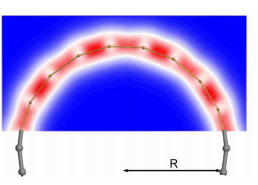ORIGINAL: MIT Technology Review
August 15, 2013
Chemists have calculated that chains of double or triple-bonded carbon atoms, known as carbyne, should be stronger and stiffer than any known material.
 |
| Photo: Rice University |
 |
| Add caption |
The sixth element, carbon, has given us an amazing abundance of extraordinary materials. Once there was simply carbon, graphite and diamond. But in recent years chemists have added buckyballs, nanotubes and any number of exotic shapes created out of graphene, the molecular equivalent of chickenwire.
So it’s hard to believe that carbon has any more surprises up its sleeve. And yet today, Mingjie Liu and pals at Rice University in Houston calculate the properties of another form of carbon that is stronger, stiffer and more exotic than anything chemists have seen before.
The new material is called carbyne. It is a chain of carbon atoms that are linked either by alternate triple and single bonds or by consecutive double bonds.
Carbyne is something of a mystery. Astronomers believe they have detected its signature in interstellar space but chemists have been bickering for decades over whether they had ever created this stuff on Earth. A couple of years ago, however, they synthesised carbyne chains up to 44 atoms long in solution.
The thinking until now has been that carbyne must be extremely unstable. In fact some chemists have calculates that two strands of carbyne coming into contact would react explosively.
Nevertheless, nanotechnologists have been fascinated with potential of this material because it ought to be both strong and stiff and therefore useful. But exactly how strong and how stiff, no one has been quite sure.
This is where Liu and co step in. These guys have calculated from first principles the bulk properties of carbyne and the results make for interesting reading.
For a start, they say that carbyne is about twice as stiff as the stiffest known materials today. Carbon nanotubes and grapheme, for example, have a stiffness of 4.5 x 10^8 N.m/kg but carbyne tops them with a stiffness of around 10^9 N.m/kg.
Just as impressive is the new material’s strength. Liu and co calculate that it takes around 10 nanoNewtons to break a single strand of carbyne. “This force translates into a specific strength of 6.0–7.5×10^7 N·m/kg, again significantly outperforming every known material including graphene (4.7–5.5×10^7 N·m/ kg), carbon nanotubes (4.3–5.0×10^7 N·m/ kg), and diamond (2.5–6.5×10”7 N·m/kg4),” they say.
Carbyne has other interesting properties too. Its flexibility is somewhere between that of a typical polymer and double-stranded DNA. And when twisted, it can either rotate freely or become torsionally stiff depending on the chemical group attached to its end.
Perhaps most interesting is the Rice team’s calculation of carbyne’s stability. They agree that two chains in contact can react but there is an activation barrier that prevents this happening readily. “This barrier suggests the viability of carbyne in condensed phase at room temperature on the order of days,” they conclude.
All this should whet the appetite of nanotechnologists hoping to design ever more exotic nanomachines, such as nanoelectronic and spintronic devices. Given the advances being made in manufacturing this stuff, we may not have long to wait before somebody begins exploiting the extraordinary mechanical properties of carbyne chains for real.
Ref: arxiv.org/abs/1308.2258 : Carbyne From First Principles: Chain Of C Atoms, A Nanorod Or A Nanorope?

No hay comentarios:
Publicar un comentario
Nota: solo los miembros de este blog pueden publicar comentarios.